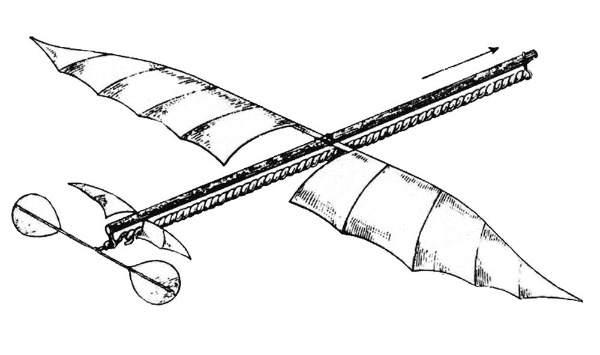
|
Alphonse Pénaud | ||
|---|---|---|---|
| |
|
||

|
|||
|
The Pénaud Planophore - 1871 & 1872
| |||
| As the end of the nineteenth century was approaching, it was becoming apparent, due to the advancement in technology, that manned flight was on the threshold of becoming a reality. With the Industrial Revolution in full swing, capital was trickling into aviation experiments. In 1890, Clément Ader, a French electrical engineer, who was a pioneer in the development of the telephone, had built a full scale machine called the Éole. From 1891 to 1894, Hirmam Maxim, the inventor of the machine gun, built and tested a four ton machine that was driven along elaborate rails.1 Both machines were unsuccessful as they would only skirt a few inches above the ground—probably as a result of Ground Effect rather than true flight. | |||
|
One of the most influential people to influence the field of aviation during the nineteenth century was the French marine engineer, Alphonse Pénaud. Stricken to a wheel chair with a debilitating hip disease from an early age, he built many models of which the Planophore would be his most promising model built, and is representative of the form that would become the modern airplane of today. Pénaud also introduced the use of twisted rubber bands to power his models, which is also still in use today—a development that many modern modelers would greatly appreciate, if only they knew of its origin.
The Planophore is an important link between Sir George Cayley (who is considerd the Father of Aviation) and the modern airplane.2 Pénaud demonstrated the Planophore to the Société de Navigation Aérienne in the Tulleries Gargens. The model flew 131 feet, setting a new record for a flying toy—proving that heavier-than-air flight was possible.3 Discovered at the beginning of the nineteenth century by George Cayley, but not quite understood, Pénaud was the first to theorize and demonstrate the principle of Inherent Stability. Inherent Stability is the tendency of an aircraft to return to straight and level flight, when the controls are released by the pilot. Most aircraft are designed with this in mind and are said to be "inherently stable." One of Pénaud's greatest achievement was achieving roll stability by the use of wing dihedral.4 A toy helicopter of the type that was designed by Alphonse Pénaud was given to Wilbur and Orville Wright by their father Milton. It made such an impression on the boys that it inspired them to develop their own airplane that would someday carry a man into flight.5 Frustrated and in ill health, Alphonse took his own life at the age of thirty in 1880. The Wright Brothers have credited him as an important predecessor and attributed part of their success to the contributions of Alphonse Pénaud. | |||
End Notes:
|
1. Peter L. Jacob. Visions of a Flying Machine, The Wright Brothers and the Process of Invention. (Washington, D.C.: Smithsonian Institution, 1990). 26. 2. Ibid. 28-30. 3. Beril Becker. Dreams and Realities of the Conquest of the Skies. (New York: Atheneum, 1967). 107-110. 4. Tom Crouch. The Bishop's Boys: A Life of Wilbur and Orville Wright. (New York: W.W. Norton & Company, 1989). 169. 5. Henry Serrano Villard. Contact! The Story of the Early Birds, Man's fisrt decade of flight from Kitty Hawk to World War I. (New York: Bonanza Books, 1968.) 17. |
Return to Early Index
© The Aviation History On-Line Museum.
All rights reserved.
November 30, 2009.